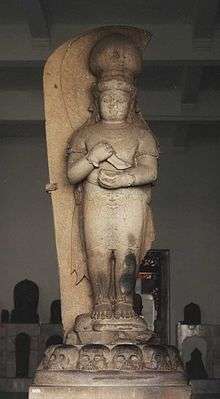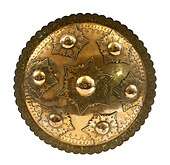Karambit
The karambit (as is spelled in the Philippines and in most Western countries[1]), kerambit (as used in both Indonesian and Malay), kurambik, karambol or karambiak (both from the Minangkabau language) is a small Indonesian curved knife resembling a claw.
| Karambit | |
|---|---|
A traditional karambit. | |
| Type | Concealed blade/farming tool |
| Place of origin | Indonesia (West Sumatra) |
| Specifications | |
| Blade type | Single, double or triple edged, crescent curve |
| Hilt type | Water buffalo horn, wooden, ivory |
| Scabbard/sheath | Water buffalo horn, wooden |
Origin

The karambit is believed to have originally been weaponized among the Minangkabau people of West Sumatra[2] where, according to folklore, it was inspired by the claws of a tiger. As with most weapons of the region, it was originally an agricultural implement designed to rake roots, gather threshing and plant rice in most of island Southeast Asia. It's a smaller variant of the Southeast Asian sickles (Filipino garab and karit; Indonesian celurit, arit, or sabit; and Malaysian sabit). As it was weaponised, the blade became more curved to maximise cutting potential. Through Indonesia's trade network and close contact with neighbouring countries, the weaponization of the karambit was eventually dispersed through what are now Thailand, Cambodia, Laos, Myanmar and the Philippines.[3][4]
Culturally, the karambit was a subject of condescension in Java because of its history as a weapon of the agrarian peasantry, as opposed to the kesatria (warrior class) who were trained in the keraton or royal palace. European accounts tell that soldiers in Indonesia were armed with a kris at their waist or back and a spear in their hands, while the karambit was used as a last resort when the fighter's other weapons were lost in battle. Nevertheless, it was popular among women who would tie the weapon into their hair to be used in self-defense. . The renowned Bugis warriors of Sulawesi were famous for their embrace of the karambit. Today it is one of the main weapons of silat and is commonly used in Filipino martial arts as well.[5]
Superficially, the karambit resembles the jambiyah but there is no connection. The jambiyah was always designed as a weapon and serves as a status marker, often made by skilled artisans and jewelers using precious stones and metals, whereas the karambit was and still remains an unadorned, modest farmer's implement and useful utility knife.[5]
Technique
The karambit is held with the blade pointing downward from the bottom of the fist, usually curving forwards however occasionally backwards. While it is primarily used in a slashing or hooking motion, karambit with a finger ring are also used in a punching motion hitting the opponent with the finger ring. Some karambit are designed to be used in a hammering motion. This flexibility of striking methods is what makes it useful in self-defense situations. The finger guard makes it difficult to disarm and allows the knife to be maneuvered in the fingers without losing one's grip.[5]
The short Filipino karambit has found some favor in the West because such proponents allege the biomechanics of the weapon allow for more powerful cutting strokes and painful "ripping" wounds, and because its usability is hypothesized as more intuitive, though there continues to be debate about this matter.
The technique of the karambit is also heavily focused on striking the weak points of the human body, such as the muscles from the knee and elbow. This is a very effective technique because of the curved blade. Because of this, the karambit is considered to be one of the deadliest melee weapons.[5]
Variations
_with_Sheath_MET_36.25.823ab_002june2014.jpg) |
_with_Sheath_MET_36.25.869ab_005july2014.jpg) |
_with_Sheath_MET_36.25.873ab_002july2014.jpg) | |
| An 18th-19th century Malayan style Karambit (left), an 18th-19th century Sulawesi style Karambit (top) and a 16th-19th century Sumatran style Karambit (bottom). | |
There are many regional variants of karambit. The length of the blade, for example, could vary from one village or blacksmith to another. Some have no finger guard and some feature two blades, one on each side of the handle. Traditional types include:
- Kuku Bima: Bhima's claw from West Java
- Kuku Hanuman: Hanuman's claw from West Java
- Kuku Machan: tiger's claw, endemic to Sumatra, Central Java and Madura
- Kerambit Sumbawa: larger, sturdier kerambit made specially for battle. From the Sumba Islands
- Kerambit Lombok: larger, sturdier kerambit made specially for battle. From Lombok
- Lawi Ayam: chicken's claw, created by the Minang community
Additionally, modern karambit may have spikes or spurs on the front or rear ricasso, which may be intended for gripping clothing or horse tack, tearing flesh or for injecting a poison, such as the upas.[6]
Modern forms
The modern Western interpretation of the karambit is far removed from the original agricultural tool. They may have folding blades, are finished to a high standard, made from expensive materials as opposed to being rudimentary and makeshift and are generally larger to accommodate larger hands.[7]
The West has recently found the karambit to be useful for self-defense, prepping and survival because, by design, they are difficult for an opponent to dislodge from the hand and this provides a combative advantage. Western versions also include one or more safety rings. Preppers also use the karambit for backpacking, camping, fishing, farming, gardening and hunting. Most of those produced in the West for use as weapons are based on the small Filipino variety, which features a short blade and index finger ring. Both fixed blade (generally double-edged) and folding (generally single-edged) karambit are produced in mass production knife factories and also by custom bladesmiths. A very similar weapon (possibly developed without connection to the Eastern variant) is found on the horn of Africa (mainly Ethiopia) where it is used for protection from hyenas together with the traditional Ethiopian stick (dulla). It is called mintcha in Amharic and is seen both with and without a finger ring. It has a thicker blade neck than traditional karambits (about a centimeter thick) and is today most often made out of rebar, if still found on the market.[8]
See also
- Bagh naka
References
- Farrer, D. S. (5 June 2009). Shadows of the Prophet: Martial Arts and Sufi Mysticism. Springer Science & Business Media. p. 91. ISBN 978-1-4020-9356-2.
- Agus Mulyana (2010). "KERAMBIT: Senjata Genggam Khas Minangkabau". Sumedang Online. Archived from the original on 28 January 2015. Retrieved 9 October 2014.
- Proyek Pembinaan Permuseuman Jakarta (Indonesia). Koleksi pilihan museum-museum negeri propinsi. Proyek Pembinaan Permuseuman Jakarta: 1989. 65 pages
- D. Christo (2014). "Karambit FAQ". Karambit.com.
- Tarani, Steve (2002). Karambit: Exotic Weapon of the Indonesian Archipelago. Unique Publications. pp. 15–22. ISBN 978-0-86568-206-1.
- Sheikh Shamsuddin. The Malay art of self-defense: silat seni gayong. North Atlantic Books, 2005 ISBN 1-55643-562-2, ISBN 978-1-55643-562-1. 247 pages. pp234
- Emerson, Ernest (February 2004). "The Battle Blade". Black Belt Magazine. Los Angeles, California: Active Interest Media, Inc. 42 (2): 80–85. ISSN 0277-3066. Retrieved 3 March 2015.
- Jean Claude Corbeil, Visual Amharic Dictionary, p. 140
.jpg)
.jpg)


